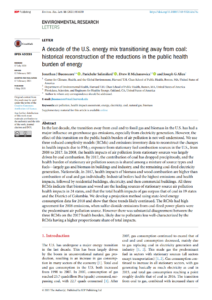Full Title: A Decade of the U.S. Energy Mix Transitioning Away from Coal: Historical Reconstruction of the Reductions in the Public Health Burden of Energy
Author(s): Jonathan J Buonocore, Parichehr Salimifard, Drew R Michanowicz, Joseph G Allen
Publisher(s): Environmental Research Letters
Publication Date: May 5, 2021
Full Text: Download Resource
Description (excerpt):
In the last decade, the transition away from coal and to fossil gas and biomass in the U.S. has had a major influence on greenhouse gas emissions, especially from electricity generation. However, the effect of this transition on the public health burden of air pollution is not well understood. We use three reduced complexity models (RCMs) and emissions inventory data to reconstruct the changes in health impacts due to PM2.5 exposure from stationary fuel combustion sources in the U.S., from 2008 to 2017. In 2008, the health impacts of air pollution from stationary sources was largely driven by coal combustion. By 2017, the contribution of coal has dropped precipitously, and the health burden of stationary air pollution sources is shared among a mixture of source types and fuels—largely gas and biomass in buildings and industry, and the remaining coal-fired electricity generation. Nationwide, in 2017, health impacts of biomass and wood combustion are higher than combustion of coal and gas individually. Industrial boilers had the highest emissions and health impacts, followed by residential buildings, electricity, and then commercial buildings. All three RCMs indicate that biomass and wood are the leading sources of stationary source air pollution health impacts in 24 states, and that the total health impacts of gas surpass that of coal in 19 states and the District of Columbia. We develop a projection method using state-level energy consumption data for 2018 and show that these trends likely continued. The RCMs had high agreement for 2008 emissions, when sulfur dioxide emissions from coal-fired power plants were the predominant air pollution source. However there was substantial disagreement between the three RCMs on the 2017 health burden, likely due to pollutants less well-characterized by the RCMs having a higher proportionate share of total impacts.
